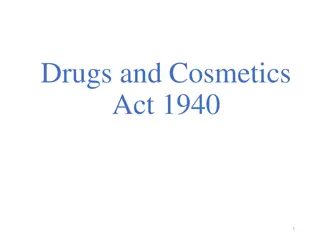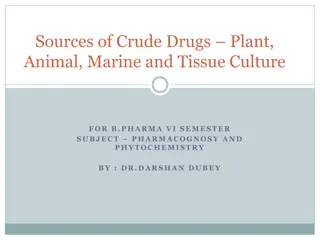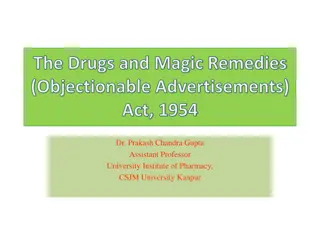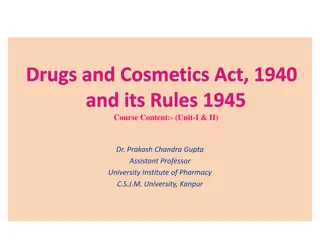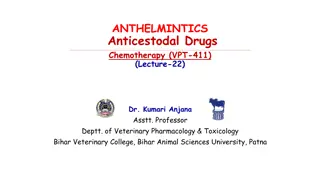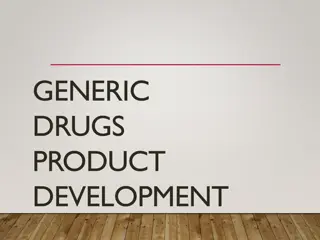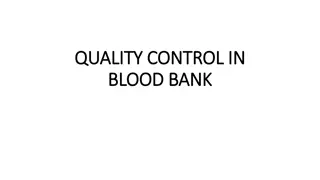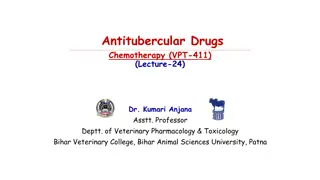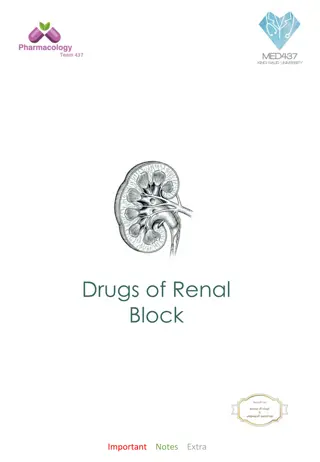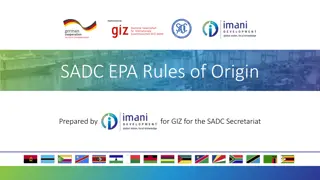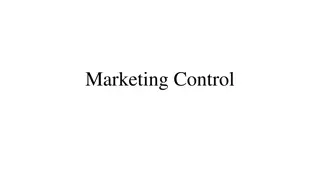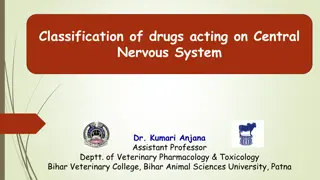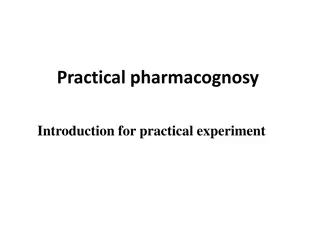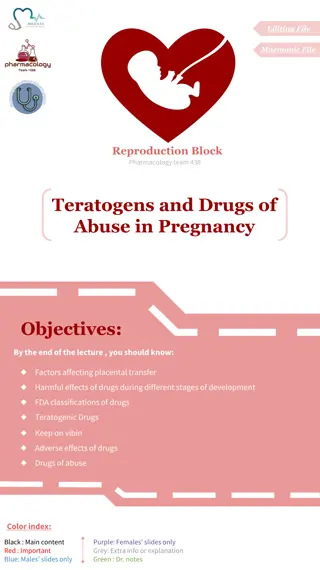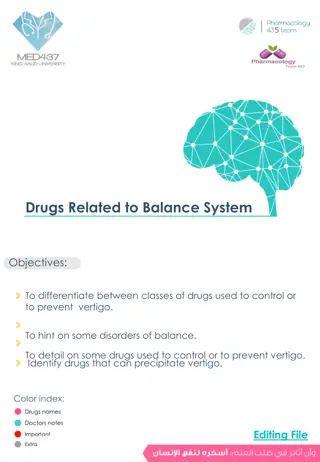Quality Control of Drugs of Natural Origin
This chapter delves into the various methods of detecting adulteration in crude drugs, with examples and evaluation techniques to preserve their quality. It discusses deliberate and unintended forms of adulteration, their detection methods, and reasons behind deliberate adulteration. The content emphasizes the importance of quality control and outlines how harmful substances can adulterate natural drugs.
Download Presentation

Please find below an Image/Link to download the presentation.
The content on the website is provided AS IS for your information and personal use only. It may not be sold, licensed, or shared on other websites without obtaining consent from the author.If you encounter any issues during the download, it is possible that the publisher has removed the file from their server.
You are allowed to download the files provided on this website for personal or commercial use, subject to the condition that they are used lawfully. All files are the property of their respective owners.
The content on the website is provided AS IS for your information and personal use only. It may not be sold, licensed, or shared on other websites without obtaining consent from the author.
E N D
Presentation Transcript
Quality control of drugs of natural origin Friday, March 17, 2023
Scope- This chapter involves various methods of crude drug adulteration with suitable examples along with different types of evaluation methods to check the adulterationand maintain the quality of crude drug. Learning outcomes- 1. Student will learn that how a genuine drug is adulterated to gain profit or by fault. 2. Student will learn the meaning and importance of quality control. 3. Student will learn about various methods to check the quality and purity of a crude drug. Friday, March 17, 2023
Adulteration It is the process of admixture of genuine articles with spurious, inferior, defective and artificial substances. These all substances are known as Adulterants.Adulteration can be done by- Sophistication-Addition of cheap, inferior or spurious material. Substitution- Genuine drug is substituted with different drug. Admixture-Addition of adulterant by accident, ignorance and carelessness. Deterioration/ Inferiority- Imperfect quality of drug due to destruction or removal of active phytoconstituent. Spoilage- Drug is destroyed by the action of bacteria, fungi, insect or rodents. Harmful materials- Addition of harmful materials/ heavy metals. Adulteration is of two types- Deliberate/ Intended/ Direct- Done to gain profit. In deliberate/ Unintended/ Indirect- By fault. Not done for profit. Adulteration can be detected by- Methods of quality control/ Standardization/ Evaluation Friday, March 17, 2023
Friday, March 17, 2023
In deliberate adulteration- It may occur due to following reasons- 1. By faulty collection of drug at wrong time, in wrong weather or other part is collected. Ex. Collection of Senna stem in place of leaves,Wild cherry bark should be collected in autumn season. 2. By imperfect preparation and processing of crude drugs. Example- Cork part is not removed properly from Ginger rhizome, Digitalis leaves are dried at more than 60 degree temperature. 3. By improper storage. Example- If volatile oils are not stored properly in air tight amber colour container. 4. Due to common vernacular names of different drugs. Example- Brahmi common name for two plants- Bacopa monnieri and Hydracotyl asiatica Friday, March 17, 2023
Deliberate adulteration- It may occur due to following reasons- 1. Adulteration with artificially manufactured substance in crude drug. Ex. Paraffin wax in Bees wax. 2. Adulteration with inferior quality material (sophistication). Ex. Alexandrian Senna is added in Indian Senna. 3. Adulteration with exhausted material. Ex. Volatile oil containing drugs are added with exhausted material. 4. Adulteration with harmful substances. Ex. Brick powder is mixed with Chilli powder. 5. Adulteration with excessive adventitious material. Ex. Excessive amount of stem in added in Senna. 6. Adulteration with superficially similar but inferior drug. Ex. Saffron is mixed with flowers of Carthamus tinctorious. 7. Adulteration with vegetative material. Ex. The lower plants like mosses, liver worts, epiphytes are added with crude drug. Friday, March 17, 2023
Adulteration can be checked by methods of Evaluation. Evaluation/ Standardization/ Quality control Evaluation is an elaborate process of establishing the correct identity of a drug and of determining its quality ad purity. Evaluation of a drug can be done on the spot by using some Organoleptic methods or in the laboratory by the use of microscopical, chemical, biological and physical methods. On this basis various types of evaluation are- 1. Organoleptic Evaluation (Macroscopic/ Morphological) 2. Microscopic Evaluation 3. Chemical Evaluation 4. Physical Evaluation 5. Therapeutic/ Pharmacological/ Biological evaluation Friday, March 17, 2023
Organoleptic Evaluation (Macroscopic/ Morphological)- It involves the use of the organs of sense and depends on the macroscopic appearance and sensory characters of the drug, such as its gross morphology, shape and size, colour and external markings and odour and taste. Examples- Camphor-aromatic odour, Ginger,capsicum-pungentodour. Cardamom- green colour fruit Cinnamon- brown color bark Fractured surface- cinchona Lemon-sour taste Honey-sweet Friday, March 17, 2023
MicroscopicEvaluation It is done with the aid of microscopes and utilizes various microscopic characters of the drugs, such as trichomes, calcium oxalate crystals, starch grains, pollen grains, etc. and their histological features, such as types and arrangements of various cells and tissues. This method of evaluation is indispensable in the evaluation of powdered drugs, as they possess very few macroscopical characters other than colour, odour and taste. Microscope is also essential for determining some important physical constants like stomata number, stomatal index, palisade ratio, vein-islet termination number, etc. of leaf drugs. This type of microscopical determinations is otherwise known as Quantitative microscopy. It also includes counting of cells by Lycopodium spore method. number, vein Friday, March 17, 2023
Chemical evaluation It involves both qualitative and quantitative determinations of their active principles. In this method characteristic qualitative chemical tests are employed to identify crude drugs and their constituents. Quantitative chemical assays are used to determine their quality and purity. This method of evaluation is now widely used in the examination of crude drugs for its accuracy and reliability. Various specific chemical tests have been established for identification and quality determination of different drugs. Generally it is completed in two parts- 1. Preliminary phyto-chemicalscreening 2. Particular chemical test for different phyto-constituent Examples- For alkaloids- Dragendroff s test, Mayer s test, Wagner s test For cardiac glycosides- Legal test, Baljet test, Killer Killiani test For steroids-Liebermann- Burchard reaction For carbohydrates- Molish test, Fehling solution test etc. Friday, March 17, 2023
PhysicalEvaluation The Physical evaluation of crude drugs is accomplished by the determination of various physical constants using various physico- chemical techniques. The common physical constants used to evaluate crude drugs and their extracted chemical principles include specific gravity (particularly of the fats and volatile oils and some crude drugs as Nutgalls), optical rotation (of some alkaloids in solution and of volatile oils), refractive index (particularly of the volatile and fixed oils), melting points (of isolated alkaloids and their derivatives), ash values (of most crude drugs) and extractive values (of most crude drugs). All the above methods and types of evaluation are appropriately used to achieve the various objectives of evaluation of crude drugs, that is, to establish their identity (correct source), purity (absence of adulterants) and quality (presence of required amount of active constituents). Friday, March 17, 2023
Biologicalevaluation This Biological evaluation of crude drugs is very useful in determining the potency of drug sample. In this type of evaluation the extent of pharmacological activity of the drug or its constituents is taken as the basis of quality. Since living organisms or their isolated living tissues are used, this method is also called the biological method or bioassay. Many drugs, particularly the antibiotics, toxins and toxoids and also vitamins are assayed by this method. Examples- 1. Analgesic activity is evaluated by Hot plate method,Tail flick method 2. Antipyretic activity is evaluated byYeast induced pyrexia method 3. Anti-inflammatory activity is evaluated by Carageenan induced rat paw edema Friday, March 17, 2023



